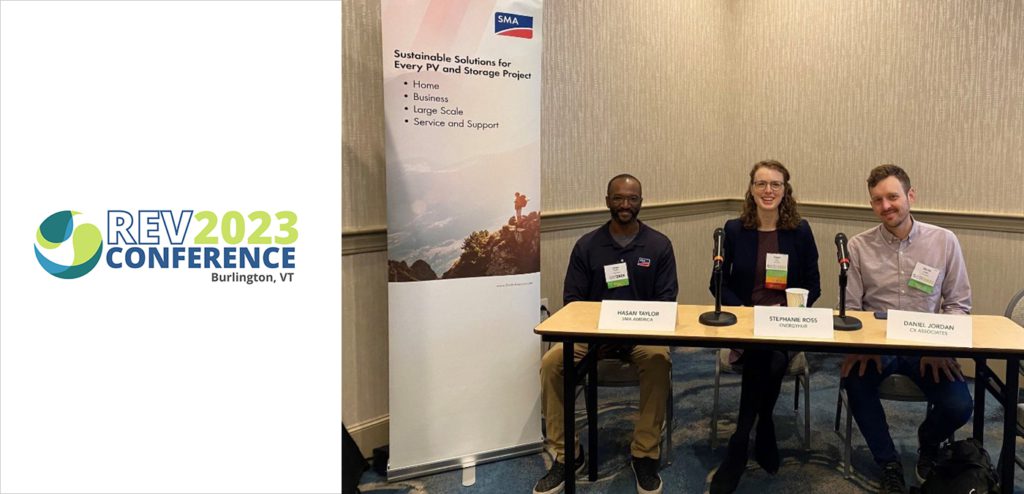Highlights from REV 2023 Path Toward a Sustainable Future
SMA America played an important role in the Northeast’s largest renewable energy gathering, the REV 2023 Conference, held in Burlington, Vermont, this past October. Highlights from REV 2023 path toward a sustainable future were discussed amongst like-minded leaders across various industries, policymakers, regulators, academics and community organizers.
SMA America’s Impact at REV 2023
 Hasan Taylor, senior applications engineer at SMA America, participated in a speaking session at REV 2023 conference, providing insights into the evolving technologies shaping the renewable energy future. Hasan discussed current residential market trends, solutions and the impact of the residential market on the path to a renewable future. The growth in the residential market is fueled by the increasing demand for electrification, the IRA, Net Metering reforms, rising utility rates and grid instabilities.
Hasan Taylor, senior applications engineer at SMA America, participated in a speaking session at REV 2023 conference, providing insights into the evolving technologies shaping the renewable energy future. Hasan discussed current residential market trends, solutions and the impact of the residential market on the path to a renewable future. The growth in the residential market is fueled by the increasing demand for electrification, the IRA, Net Metering reforms, rising utility rates and grid instabilities.
According to Wood Mackenzie’s Q3 2023 US Solar Market Insights, the residential solar market is projected to grow by an average of 6% from 2023 to 2028. This growth anticipates a significant demand for residential PV inverters. Homeowners are turning to solar power to counter escalating utility costs and grid instabilities. Many residents are looking for a comprehensive home solution that includes solar PV power, EV charging and battery storage. A PV system combined with battery storage ensures safety and security for homeowners in areas prone to adverse weather conditions and grid instabilities.
Navigating the Path to Net-Zero: Challenges and Solutions
Recognizing this trajectory of growth within the residential solar market is important to better understand both the opportunities and challenges that face Vermont and the Northeast region. Below you will find our biggest takeaways, findings and perspective shared from the panel and REV Conference as a whole.
- Vermont has set ambitious goals to achieve net-zero emissions by 2050, but as of today, these goals are a bit off track. Challenges arise from Vermont’s state policies, regulations and affordability, hindering progress for the state meeting a net-zero emissions goal. The state struggles to meet legally mandated goals due to a lack of regulated accountability. To mitigate the state’s emissions, promoting home weatherization and emphasizing the need for EVs has the potential to propel Vermont in the right direction.
- Nationally, the trend toward electrification has driven the demand for EVs. However, the demand for Level 2 EV charging encounters challenges, particularly in terms of residential installation. Electrical updates may be necessary for millions of U.S. homes to accommodate Level 2 EV fast charging capabilities, potentially involving time-consuming and costly processes, including disruptive trenching for outdoor service wire installation.
- In addition to the rise in electrification, high utility rates serve as a significant motivator for residents to adopt solar power. Utility companies surcharge higher utility costs during specified peak times, known as “time of use” (TOU) rates. Monthly utility bills become expensive for households relying on power during those peak hours. Energy management becomes crucial for households facing TOU rates, with peak load shifting and shaving enabling the shift of non-essential loads off the grid while maintaining power to essential household needs.
- When it comes to securing a home’s power, battery storage solutions come first to mind. With grid instabilities and unpredictable weather, many homes face rolling blackouts or power loss. Residents can ensure their power supply by opting for battery storage alongside their solar PV system. Battery storage allows homeowners to access excess power generated by their PV system during daylight hours, enabling homes to operate entirely on stored power during grid power outages, blackouts, or nighttime usage.
REV 2023 shed light on how proactive action, innovative renewable technology and strategic policymaking can support a future of sustainable and secure energy. The ongoing journey towards a bright renewable energy future depends on continued collaboration, innovation and the commitment to making environmentally conscious choices within our homes and communities.





Feel free to contribute!